JANUARY’S ENDURING JOYS
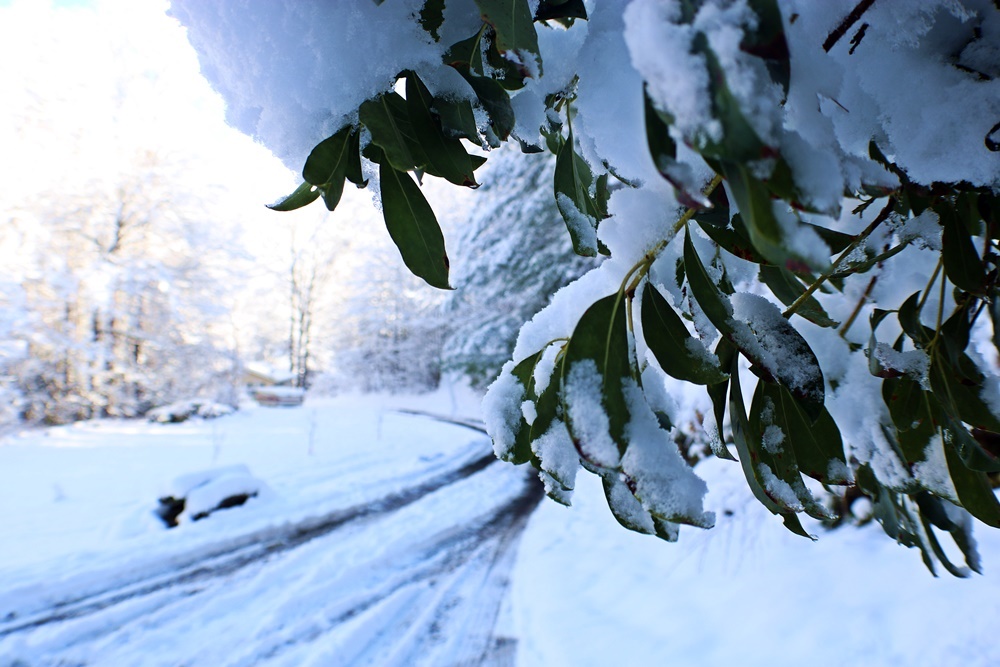
To a greater extent than any other month of the year except possibly December, there are foods, events, activities, and memories I associate with the month of January. Recently, in a weekly column I write for the Smoky Mountain Times, the little weekly newspaper serving my boyhood home of Bryson City, NC, I took a fond look back at some of these. Many of them simple in nature yet pleasures to treasure, might be of interest. That’s because, at least in part, that I suspect many if not all readers will harbor the same or similar recollections. Let me know (jimcasada@comporium.net) about your special memories of January.
SNOW DAYS—Never mind that closure of school because snow made road travel dangerous meant “make up” days in the spring, sufficient snowfall to occasion such a decision was always a moment for excitement. It seemed there were more snow days in January than any other month, and for me and a bunch of rabbit hunting buddies it meant a day afield. Often there would be nighttime activity as well, with sledding being a special favorite.
BISCUITS AND BISCUIT BREAD—Momma was a splendid cook, and she was absolutely without peer when it came to fried chicken. She did have one rather barren spot in her array of culinary skills though. When it came to biscuits she was anything but an adept. Her angel biscuits were passable and then some, but when it came to old-fashioned cathead biscuits, made from scratch, hand-kneaded, cut with an ancient pressed tin device with a handle, she had about the same level of skill I possess when it comes to music. When I say that I was hidden under a washtub when the sun of musical ability shone, that pretty well provides the picture.
Grandma Minnie, on the other hand, was a biscuit wizard. She turned out fluffy, light, high-rising cathead biscuits virtually every day, and about the only thing I considered their equal was what she called a flumlolly (a small biscuit that used the remaining dough after all catheads had been cut). I liked flumlollies because they got a bit browner and crispier than their larger partners. I relished that extra crunch. Sometimes when Grandma was too busy to take the bit of added time required to cut individual biscuits, she would just make biscuit bread. On those occasions she prepared the dough as always but just flattened it out and baked it in one piece. This “biscuit bread” or “biscuit pone” as she styled it, was ideal for crumbling up in a bowl of soup beans or for sopping syrup.
SOPPING BUTTER AND SYRUP—A favorite use for biscuits in my family was to use them to run through or sop up a mixture of syrup (or sometimes, honey) and butter. This was produced by putting a sizeable pat of butter on one’s plate or saucer, pouring syrup over it, and using a fork to mash and blend it all together. Then it was time to bring one of Grandma’s biscuits into play. Sometimes things didn’t work out evenly with the sopping mix and biscuit, but Grandpa had the perfect solution to that. “I reckon the only thing better than a sopping biscuit with syrup and butter is two of ‘em.”
Although we often used locally made sorghum syrup or honey for sopping, one of my personal favorites was a clear store-bought concoction known as Dixie Dew. In truth I don’t think it had the same quality, taste-wise, of properly made dark sorghum syrup or fine local honey, but the label carried a message that was both irresistible and a bit of promotional genius. It read: “Covers Dixie like the dew and gives a biscuit a college education.” That phrasing always enchanted me.
MAKING SLING SHOTS—Over the course of my adolescent years I must have fashioned a score or more slingshots. Most of them involved appreciable help from either Daddy or Grandpa Joe, but by the time I reached the age where I was the proud possessor of a gun and thereby lost a good bit of my interest in slingshots, I could pretty well undertake the task on my own. For Grandpa, in particular, the entire process was one to be approached with almost scientific precision.
It began with joyful late winter walks through the woods in search of just the right size and shape of dogwood fork, although in most cases there had been some preliminary scouting on that front as we wandered around in the late summer or fall. Once a fork had been chosen it was sawed off, worked on, and whittled until everything was just right. Then came the finishing touches—rubber from an old tire tube cut to the appropriate length, a leather patch to hold the rock (or sometimes, a marble) serving as ammunition, and careful work with waxed twine to attach both the patch and the rubber. At that point it was time for some real fun in the form of “shooting” the slingshot. I was never an exceptional marksman, but I had two cousins who were absolute wizards. They could cut a corn stalk into or hit a bedded rabbit virtually every time.
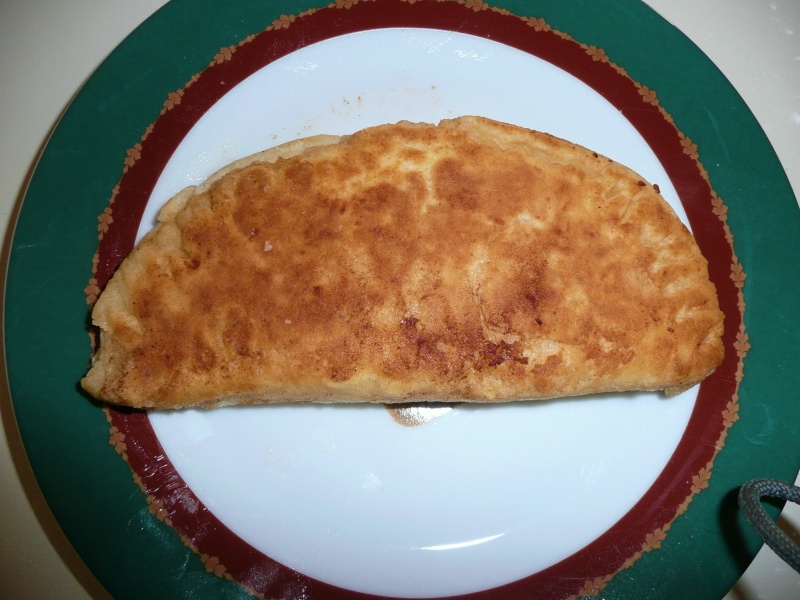
FRIED FRUIT PIES—Both Momma and Grandma Minnie would periodically produce a big batch of fried pies. Most of the time there was no evidence of precisely what motivated them to do so, but whenever it happened it was time for celebration on the part of a greedy-gut boy who loved his sweets. Normally they were made using dried apples, but occasionally there would be some variation with the delicious filling being dried peaches. Whatever the case, these fried pies (sometimes known as half moons or mule ears because of their shape) were an exercise in pure eating pleasure. They disappeared from a loaded platter as magically as melting snow in early spring.
SNOW CREAM—Speaking of snow, snow cream was another occasional January treat. Obviously it required the basic ingredient, but when we would get a decent snowfall, say four or five inches, Momma would sometimes become an adult kid (one of her most endearing features was how she did this from time to time) and say: “Let’s make some snow cream.” She’d send my sister and me, perhaps joined by some friends who seemed to flock to our house, out into the snow with a big tin dishpan and strict instructions to fill it with “clean” snow. By that she meant we needed to take care just to skim off the tip of the snow and avoid any trash by getting too close to the ground. Once the pan was suitably full, a quick trip into the house, addition of key ingredients, and a bit of stirring produced the finished delicacy.
ICE SKATING—Sometimes January would bring really cold weather and a bunch of friends would indulge in a poor mountain boy’s equivalent of ice skating. I never knew anyone who actually owned ice skates, but leather-bottomed shoes worked quite nicely on some icy patch of sidewalk or a frozen pond. Mind you, a fall when pushed by a friend resulted in major dental problems for me. Today, many decades after the fact, I’m still dealing with issues connected to landing flat on my face.
SOLITARY HUNTS—While rabbit hunting was my primary focus on that front in January, and notwithstanding the fact that rabbit hunting is a group sport, I often hunted alone when a snow day off from school or some other circumstance offered the opportunity. I’d take our beagles along, and rabbits would be the primary point of interest. But there was a covey of quail living close by and always the off chance of encountering a squirrel.
SQUARE DANCES—Often during the school year there would be some type of entertainment on Friday or Saturday nights for high school students. There was an old piano in a little gym that had been built by the CCCs, and I still retain fond memories of a talented pianist hammering out grand square dance tunes such as “Down Yonder” and “Under the Double Eagle.” There would be an adult caller, several other adults (most of them high school teachers who graciously sacrificed some spare time to serve as chaperones), and dozens of students who turned out for dancing an innocent fun.
Ah, those were the days.
A BUNDLE OF BOOK BARGAINS
As I sort through books I have in stock and do some major moving/rearranging thanks to rental costs on storage sheds I’ve used for years going up exponentially (I’m having my own shed built), it’s time to offer some serious bargains and reduce the quantity of material I’m holding. Since I’ve specialized in out-of-print turkey books for a long time, most of the bargains are there. But there are also a few more at the beginning of the list below, Before getting to that, I’m reluctantly raising shipping costs after a decade and more of holding steady. The woefully mismanaged and inept Post Office just keeps raising prices, and even though they remain the cheapest way to ship, I’ve got to make some adjustments. Also, supply costs have gone up sharply (I use high-quality boxes in an effort to make sure things get to you in good order and undamaged). As of now postage costs will be at a base rate of $6, with two books being $9 and three or more $12. Insurance will be $3.50 per $100 of coverage.
Now here are the special offerings. Payment should be by check or money order—no PayPal on these specials. Send payment to Jim Casada, 1250 Yorkdale Drive, Rock Hill, SC 29730.
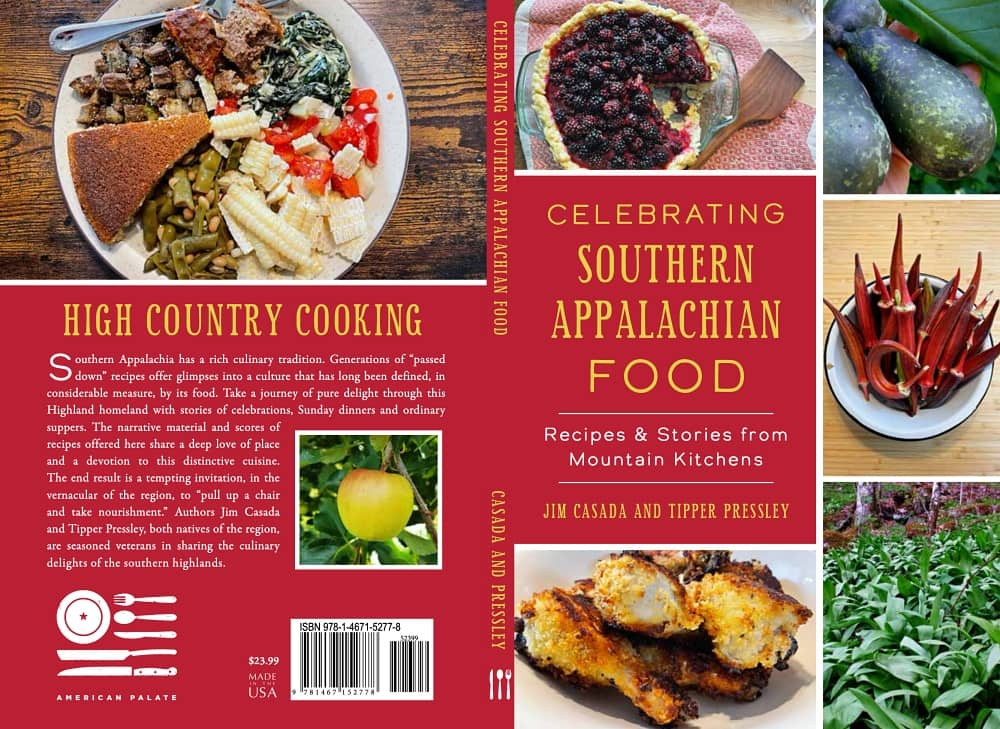
Many of you have pre-ordered the cookbook, Celebrating Southern Appalachian Food: Recipes & Stories from Mountain Kitchens, I’ve co-authored with Tipper Pressley. Just a couple of hours ago I got an e-mail indicating all our proof corrections were in hand with the publisher, and things continue to progress nicely towards the scheduled May 1 publication date. You can still pre-order at the list price ($23.99) and shipping will be free (now a savings of $6). Just send a check to the address given above.
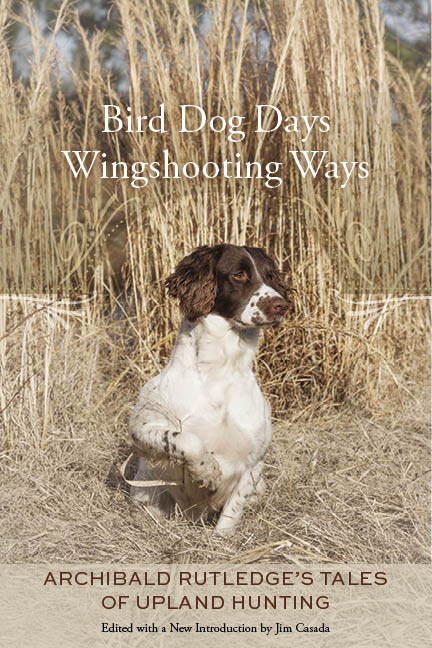
I’ve got a big surplus of one of the Archibald Rutledge anthologies I’ve edited and compiled, Bird Dog Days, Wingshooting Ways: Archibald Rutledge’s Tales of Upland Hunting. The book retails for $29.95 but I’m offering it at half price–$15.
Now for the turkey listings, and there are lots of offers here, with all price reductions being at least 50% off what I have them priced for on my turkey books list.
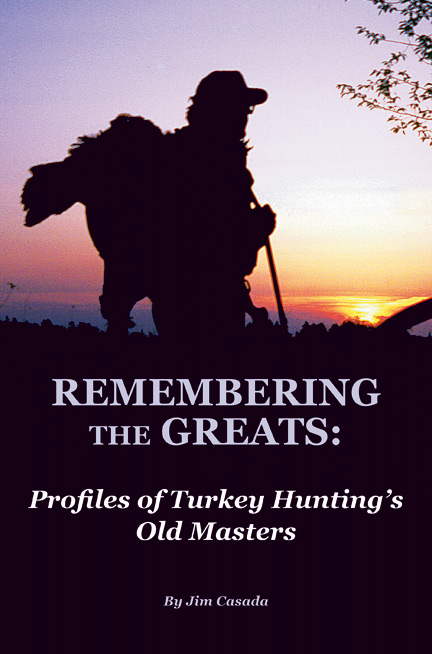
Jim Casada, Remembering the Greats: Profiles of Turkey Hunting’s Old Masters. Hardbound, lavishly illustrated, and a multiple award-winning book. Signed. $17.50
Jim Casada, The Literature of Turkey Hunting. Limited (750 copies), numbered, and signed. Lavishly bound and with a slipcase (both in glossy Skivvertex material). Gold embossing. An award-winning work. $50.
Bob Humphrey, New England Turkey Hunting. Paperbound. $10.
Brian Lovett (ed.), The Turkey Hunters. Hardbound. $15.
Gerry Blair, Turkey Hunting with Gerry Blair. Hardbound. $6.
Phil Bourjailly, Field & Stream Turkey Hunter’s Handbook. Paperbound. $5.
James Brady, Modern Turkey Hunting. Hardbound. $6.
Toby Bridges, Hunting America’s Wild Turkey. Paperbound. $9
Richard Combs, Turkey Hunting Tactics of the Pros. Hardbound. $7.50.
Richard Combs, Advanced Turkey Hunting. Hardbound. $7.50.
Neil Cost, It Was Quite a Party. Hardbound. Numbered limited edition. $20.
Bob Gooch, In Search of the Wild Turkey. $7.50.
Earl Groves, Tomfoolery 2000. Paperbound. $7.50.
Michael Hanback, Spring Gobbler Fever. Paperback. $5.
Frank Harben, Turkey Hunting in the Everglades. Paperbound. Signed. $12.
Dave Harbour, Advanced Turkey Hunting. Hardbound. $15.
Tom Kelly, Better on a Rising Tide. Hardbound. $15.
Tom Kelly, Dealer’s Choice. Hardbound. $15.
Tom Kelly, A Hat Full of Rabbits! Hardbound. $15.
Tom Kelly, Take Back in Fancy. Hardbound. $15.
Tom Kelly, Their Old Inhabitants. Hardbound. $15.
Jay Langston, Turkey Hunter’s Took Kit. Hardbound. $6
John McDaniel, The American Wild Turkey. Hardbound. $10.
E. A. McIlhenny, The Wild Turkey and Its Hunting. Hardbound (the Old Masters reprint). $35.
Same book, this one the limited edition, leatherbound reprint from Premier Press with new introductory material. Beautifully bound and lovely in every sense. $90.
Earl Mickel, Turkey Callmakers Past and Present. The first volume of his trilogy. Paperbound (poorly bound). Rare. $200.
Earl Mickel, Longbeards, Callmakers and Memories. The final volume of his trilogy. Hardbound. $17.50.
Outdoor Life, Turkey Season. Paperbound. $7.50.
Mike Pearce, Turkey Hunting with Ray Eye. Hardbound. $37.50.
John Phillips, Outdoor Life Turkey Hunting. Hardbound. $12.50.
John Phillips, Secrets of the Turkey Pros. $11.
John Phillips, Turkey Hunting Tactics of the Pros. $10.
Roger Raisch, Turkey Hunting Secrets. Paperbound. $9.
Bob Saile, Sultan of Spring. Hardbound. $7.50.
Glen Sapir, Secrets of the Turkey Pros. Hardbound. $7.50.
John Trout, Jr., The Complete Book of Wild Turkey Hunting. Hardbound. $10.
Lovett Williams, After the Hunt. Paperbound. $5.
Lovett Williams, The Book of the Wild Turkey. Paperback. $12.50.
Lovett Williams, Wild Turkey Country. Paperback. $12.50.
JIM’S DOIN’S
This section will be appreciably longer than usual thanks to a lot happening in the last few weeks and my decision to go into some detail about a deer hunting experience on the first day of the month. I’ll begin with that event and then move on to standard “Doin’s” stuff.
Our deer season here in South Carolina always ends on New Year’s Day, and the final afternoon of that last day found me sitting in a stand and thinking, as light gave way to night, that I was going to end another whitetail year with less venison in the freezer than I wanted. I had only killed two deer and ideally I want at least three and often four for the freezer. I checked my watch and saw that there were nine minutes of legal hunting left, but it was a cloudy day and already I was hunting through my rifle scope. As I looked up from my watch to a long shooting lane my stand overlooked, something seemed different. I put my eyes to the scope and sure enough, at a distance which later proved to be about 130 yards, there was a big-bodied deer. I immediately knew I would shoot it if at all possible, but as light waned rapidly it continued to mix browsing with periods of looking head on towards my stand. Finally I realized that if I was going to take a shot it would have to be straight on, in the chest area, rather than the side shot targeting the lungs/heart area I prefer. My straight-on shot from the bolt-action Remington 30-06 that has been my gun of choice in killing literally scores of deer was true. The whitetail, which turned out to be a nice seven-pointer, dropped on the spot.
Then came a bit of a dilemma. I no longer have either the stamina or the strength that once was the case, not to mention being decidedly uncertain on my feet because of neuropathy, and I was maybe a half mile from my truck. Fortunately Josh Dawkins, the son part of the father-son team who are my cherished friends, hunting buddies, and caretakers for both this old man and his property, was also hunting. I knew he had his four-wheeler on a trailer behind his truck and that all I had to do was drive to the location he had hunted, tell him where the deer was, and let the ATV take care of the rest. He was waiting on me when I arrived, but the best news was he had already retrieved the deer. He knew where I was hunting, and the tell-tale sound of a shot followed immediately by a “whump” let him know I had hit the deer. He had taken a different route to it and was back by the time I reached him. He and his father, Darrin, had the buck skinned, gutted, and in a cooler in no time flat (they’ve got all the right equipment and have it down to a matter of scientific precision). For my part, I watched the process with a celebratory libation in hand. Talk about having it made and being blessed by good friends, and I couldn’t have asked for a finer end to the season!
A few days later Josh and I worked up a whopping batch of venison burger (he had killed two deer on the penultimate day of December), with Darrin lending an expert hand with the grinding and bagging part of the process. Incidentally, our standard approach to burger is to mix pork fat, bacon ends, or maybe Boston butt with the deer meat on a ration of about one part pork to three or four parts venison. It produces meat ideal for everything from hamburgers to hearty stews, meat loaf to chili.
Otherwise I’ve been following pretty much my usual pattern of work. These words are being written while I take a break from reading the final proofs of Celebrating Southern Appalachian Food, the cookbook I’m authoring with Tipper Pressley (see “Book Bargains” above for fuller details). Both of us are quite pleased with the way everything has turned out and eagerly look forward to the appearance of the finished product on May 1. Otherwise it’s been pretty much my standard pattern of writing for magazines, peddling books, doing my weekly newspaper column, and the like. I have been actively involved in a fund-raising initiative for Winthrop University’s men’s soccer program I started way back in the mid-1970s and coached for a dozen years. I’m just a small cog in a big wheel, but I must admit to more than a modest amount of pride in the efforts and knowledge of a batch of former players, some of whom have expertise in fund raising while others have been highly successful coaches, who are bringing all of this together. I also have been blessed by the remarkable sense of togetherness these guys have demonstrated over the years. The least I can do is be supportive and help out a bit.
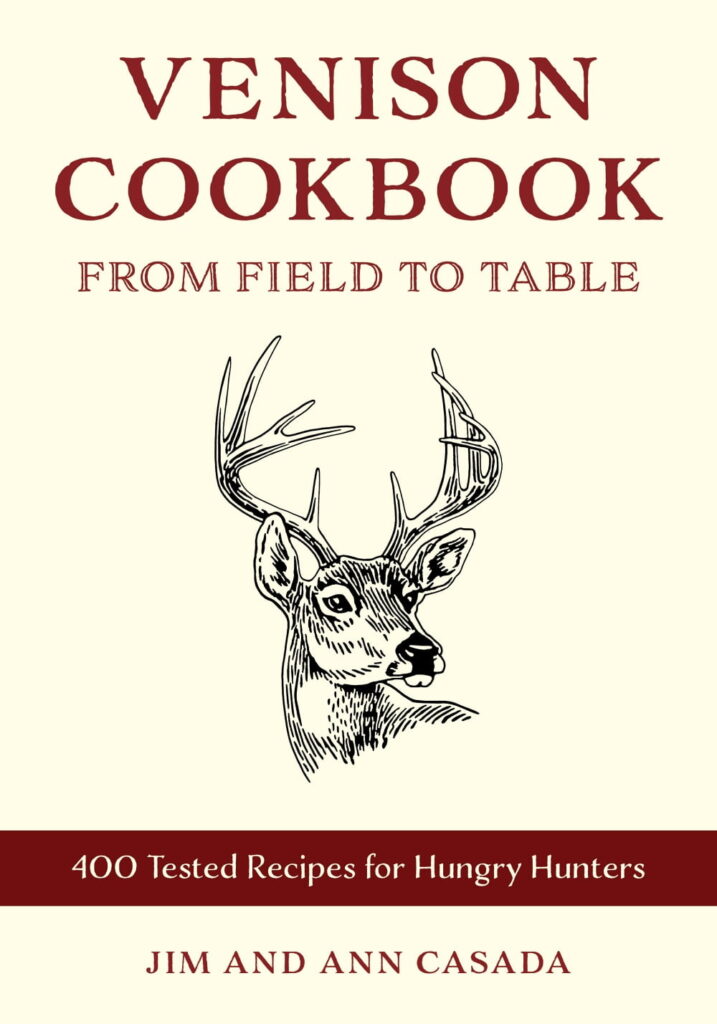
There are some noteworthy developments, book wise, on a second front. Back in the fall I signed a contract with one of the oldest outdoor publishers still in business, Stackpole, to do a book that would combine the recipe contents of the pair of venison cookbooks my late wife, Ann, and I wrote (The Complete Venison Cookbook and The Ultimate Venison Cookbook). While I kept the former work in print after the original publisher dropped it (why they did so I’ll never know because it continued to sell at a satisfactory pace), the latter has long been unavailable. Combining the two will bring together 400+ ways to use deer meat, and there won’t be a single recipe we didn’t prepare in our kitchen and taste test.
My recently published material includes “The Man Who Knew Ruark Best,” “Sporting Classics Daily,” Jan. 4, 2023; “Fred Selous: Heart of Steel,” “Sporting Classics Daily,” January 10, 2023; and “The Making of a Bibliophile,” Sporting Classics, Jan./Feb., 2023, pp. 137-42.
RECIPES
VENISON SPAGHETTI
As I noted above in “Jim’s “Doin’s,” I was fortunate enough to kill three deer this season and as a result have a decent amount of meat in the freezer. The majority of my frozen meat is in the form of ground venison. It features a mixture of roughly 80% lean, clean venison and 20% pork and pork fat. I get the latter through buying Boston butts when they occasionally go on sale at a really low price or by buying pork fat a butcher sets aside and freezes. My reason for turning much of the meat into burger is simple—it is so versatile in that form. You have the makings of hamburgers, chili, soup, lasagna, pizza topping, all sorts of Tex-Mex dishes, shepherd’s pie, and a personal favorite, spaghetti. Here’s my recipe, although one of the great things about spaghetti is that the sauce can be so varied.
1 jar of Prego or some other pasta sauce or make your own
1½ pounds ground venison
1 large onion, diced
1 garlic clove, minced
2 stalks celery cut into small pieces
2 carrots cut into small pieces
Olive oil
Red or black pepper and salt to taste
1 (15-ounce) can diced tomatoes (or, as I normally do, use chunks I have frozen)
Brown your venison in a large skillet, using just enough olive oil to keep it from sticking (may not be necessary if you have a non-stick skillet or use pork fat as I do). In a separate skillet, with a bit of olive oil, sauté the onion, carrots and celery along with the minced garlic. Once venison is nicely browned and vegetables sautéed, combine in a large pot and add tomatoes and sauce. Simmer on very low heat, checking occasionally to be sure there is no sticking, until flavors have married nicely (carrots should be tender). If you like a thick sauce you will want to simmer longer. Once the sauce is ready, prepare your spaghetti noodles, drain when al dente, top with sauce and sprinkle liberally with grated Parmesan cheese. This recipe makes quite a bit of meat sauce, but it freezes well and can be thawed and heated, then added to just-cooked noodles, for a quickly prepared meal.
Garlic toast and a lettuce or fruit salad make perfect sides.
SNOW CREAM
Here is Mom’s basic recipe, although it could be expanded as needed.
1 cup of whole milk or, for additional richness, half and half
½ cup sugar
½ teaspoon vanilla
Big bowl of snow (approximately 3 quarts)
The ingredients were stirred gently and consumed immediately. There were many variations to this basic recipe. The additional of chocolate syrup was popular, as was cocoa mix. For added richness, an egg could be beaten and stirred in the mix. Raisins soaked in water, drained, and doused with a bit of rum flavoring offered another possibility. A dusting of cinnamon along with the aforementioned egg gave an eggnog-like taste. Frozen berries could be thawed and mixed in, or overripe bananas could be mashed up. Whatever the end product, it was always a special treat.
GRANDMA’S BISCUIT BREAD
In this particular case I’ll have to confess that I have no idea of how Grandma Minnie worked her culinary magic with biscuits. I just know they were always perfect—light, fluffy, shaped by hand, and big enough to hold a fried egg from Grandpa Joe’s chickens without white sticking out over the edges. Often, if she was in a hurry, she wouldn’t make individual biscuits. She’d just get the dough ready and put it in a loaf pan for baking as biscuit bread. The taste was the same, and when it came to biscuits and gravy, it was just the ticket.
While I don’t remember Grandma’s biscuit recipe, and Momma always left this aspect of food preparation to her, this is pretty much what was involved.
2 teaspoon bacon drippings (or lard)
2 cups self-rising flour
¼ cup cold butter cut into cubes
1½ to 2 cups buttermilk
Add bacon drippings or lard to an 8-inch cast iron frying pan and place pan in cold oven. Preheat oven to 400 degrees. Place flour in bowl and cut in butter until it resembles coarse crumbs. Add buttermilk to flour mixture. The batter will be very moist but shouldn’t be runny. Pour batter into hot cast iron pan. Spread the dough evenly over the bottom of the pan. Bake for 20 to 25 minutes or until the top is golden brown. Remove from oven and flip bread out onto a cooling rack or plate. Slice or break off and serve.
About all that then remains is to slather with butter and your favorite jam, jelly, or syrup as biscuit adornment. When an advertising genius for an old-time cane syrup called Dixie Dew said it “gives a biscuit a college education” he knew whereof he spoke. Alternately, cut the cathead open and apply plenty of gravy. Let out your belt two notches and get busy with your trencherman duties!
FRIED PIES
This recipe is quite similar to how these delicacies were prepared by Mom and Grandma Minnie. Make dough for regular biscuit recipe (see above). Take a small amount of batter; on a floured surface roll ball out into a circular shape (quite thin). Place a couple of tablespoons of rehydrated apples or peaches in middle of circle. Fold dough over and seal edges by crimping with a fork or your fingers to keep all that sweet goodness inside. Poke a few holes in the top to allow steam to escape. Place in a well-greased cast iron skillet and fry, turning only once.
VEGETABLE AND VENISON SOUP
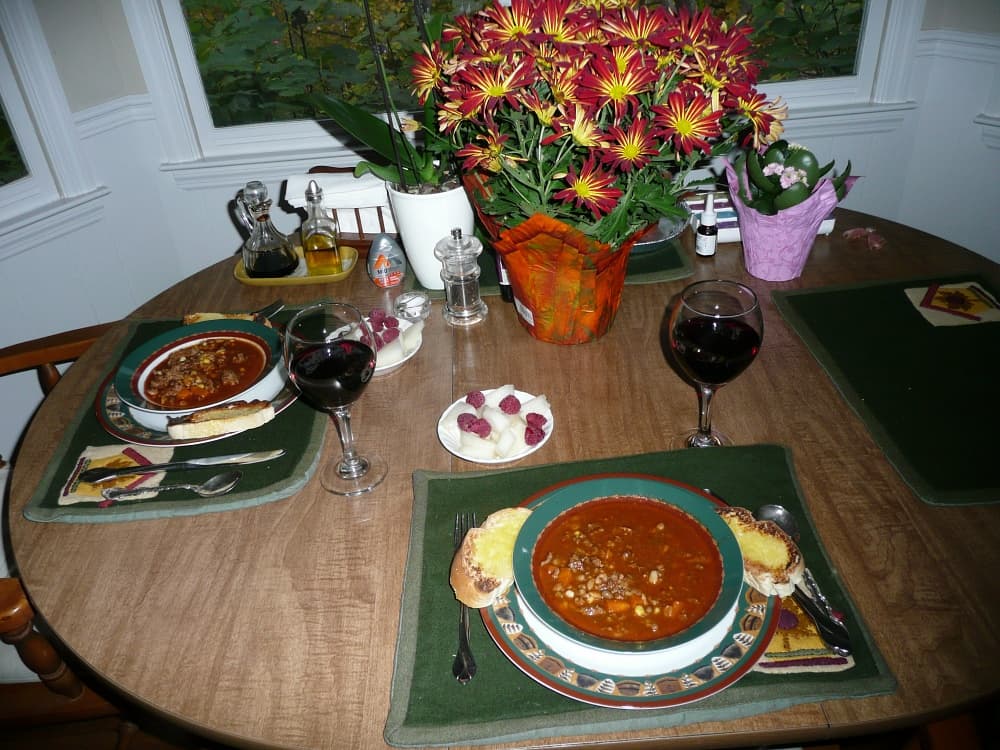
There are few things more satisfying and comforting than a steam bowl of hearty soup on a cold winter’s day. This one fits that bill in admirable fashion.
1 medium onion, chopped
1 garlic clove, minced
4 carrots, chopped
2-3 potatoes, chopped
2 stalks celery
1 zucchini, chopped
1 yellow squash, chopped
2 cups chopped venison stew meat or burger
2-3 cans beef broth
Salt and pepper to taste
1 bay leaf
1 tablespoon dried parsley
½ teaspoon Italian seasoning
In a large Dutch oven combine all ingredients and bring to a boil. Reduce heat and simmer, covered, for an hour or until all the vegetables are tender. Remove bay leaf.
Tip: You can vary the vegetables according to what you have on hand. For example, a half cup of lima beans or green beans go quite nicely, as does some canned or frozen corn.